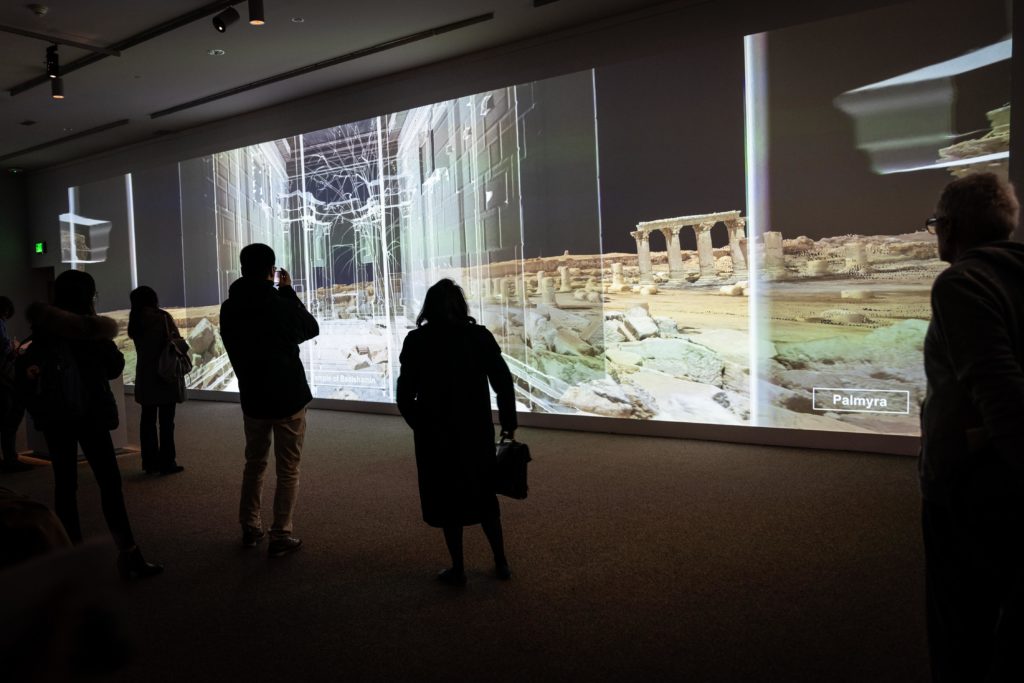By Sheila Wickouski

Enter the vibrant Souk in Aleppo, Syria. Watch as it turns to ashen ruins before your eyes. This is how Age Old Cities: A Virtual Journey from Palmyra to Mosul, at the Smithsonian’s National Museum of Asian Art, begins the immersive experience through three ancient Mideastern cities recently devastated by ISIS.
Giant screen projections expose the details of the cultural losses in the destruction of ancient archeological sites while short documentaries share what the human inhabitants of Aleppo, Palmyra, and Mosul saw up close.
Two thousand years ago in Palmyra, the Romans built a temple and theater in the ancient crossroads city of the spice trade. Today those ruins are further reduced to rubble, blown up or otherwise desecrated by ISIS from 2015 to 2017. Through recordings by drones that were “digested” and combined with archival material from a 1950 archeological building surveys, algorithms and big screen 3D projections show possible future reconstructions. For contemplation and comparison, adjacent film footage of these cities show what they looked like in the early decades of the twentieth century.
While residents in Greetings from Aleppo are trying to maintain normalcy, constantly sweeping up rubble amid the sound of frequent gunshots, archeologists are seeking to resolve whether or not to restore these ruins to their original state before ISIS, or to their original state before time and neglect took their toll.
Of the tombs in the Necropolis in Palmyra, one was not totally destroyed by ISIS. The Tomb of the Three Brothers, dating from the second century CE, escaped destruction because it was used by ISIS soldiers as a barracks, complete with a canteen and an office. The artworks were trashed with white paint, covered with blankets to hide images, and the site left with piles of garbage.
Across the Tigris River from the ancient site of Nineveh, is Mosul, Iraq. Shared by three religious traditions: Judaism, Christianity, and Islam, is the biblical story of the prophet Jonah, or Naabi Yunus, who was sent to warn Nineveh of destruction. ISIS laid to waste the Mausoleum of Naabi Yunus, an ancient church which had become a medieval mosque. An unexpected outcome was that the rubble revealed fragments of the palace of seventh century BCE Assyrian king, Esahaddon, which are now being studied by archeologists.
While these devastations might seem far away, there is one building that has a connection to our neighborhood. The Church of Our Lady of the Hour, still standing but stripped of interior decorations and partly destroyed, was built by Dominicans, who also built St. Dominic in Southwest DC around the same time the late 19th century. What appears archaic and remote might not seem so far away in time and place anymore.
The exhibit includes a virtual reality experience for five of these sites, available on the first Saturday of each month (except for July when it will be on July 11), from 12-4 p.m. in Sackler B2 – recommended for visitors ages twelve and up. Additional talks are scheduled and can be found at the Sacker’s web page (asia.si.edu/events-overview/talks/)
Age Old Cities will be on display till Oct. 25, 2020.
Due to the rapidly evolving COVID-19 outbreak, many museums have temporarily closed. For up-to-date information on the outbreak, go to https://coronavirus.dc.gov/.

